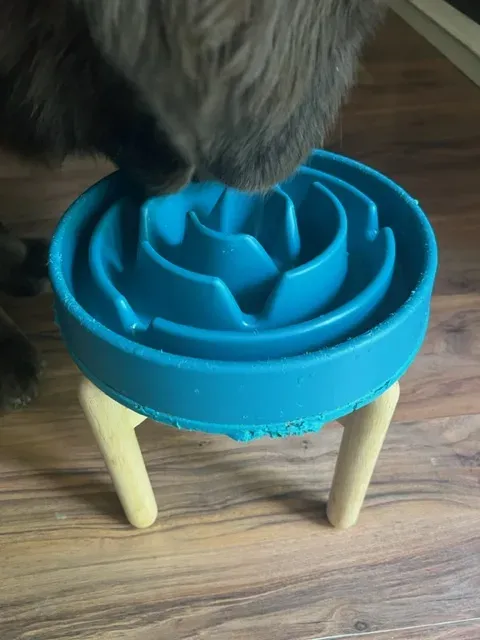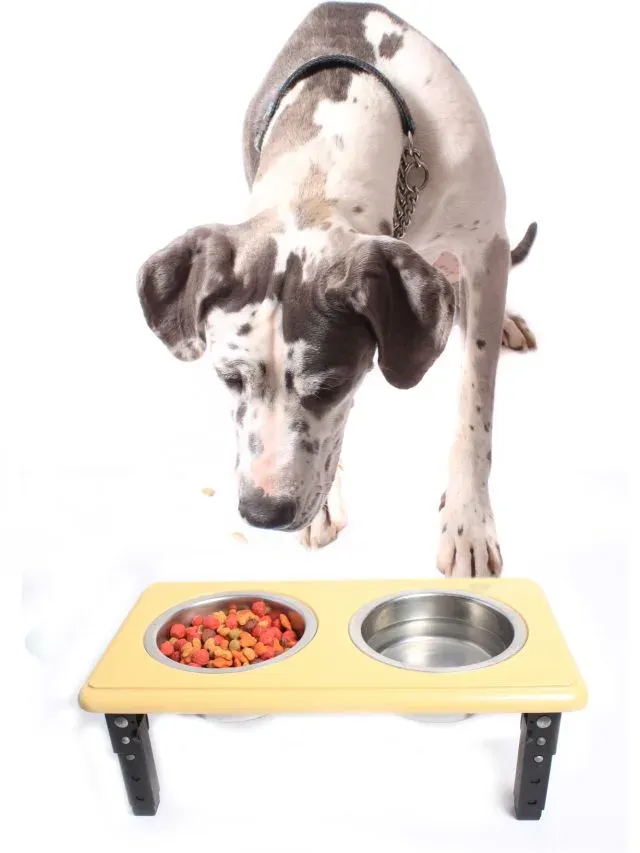For many dog owners, particularly those with large or giant breeds, the question of whether to use Raised Dog Bowls has been a long-standing point of discussion and confusion. Once widely believed to be a crucial preventative measure against the life-threatening condition of dog bloat (Gastric Dilatation-Volvulus or GDV), recent studies have cast a shadow of doubt, even suggesting a potential increase in risk. As an editor at Dog Care Story, we understand the importance of making informed decisions for our furry companions, and this article aims to cut through the noise, helping you understand the pros, cons, and the latest research surrounding elevated dog feeders. Ultimately, the best choice for your dog often comes down to individual needs and careful observation of their eating habits. If you’re wondering what you should feed my picky dog, the bowl type can sometimes play a role in their comfort and willingness to eat.
The shift in perspective regarding raised dog bowls began to gain significant traction after the initial belief that they could prevent bloat. Many large breed owners, including myself, have historically opted for elevated feeding stations for our dogs, based on the assumption that it aided digestion and reduced the risk of GDV. However, the scientific landscape has evolved, presenting us with new insights that challenge these long-held conventions.
The Purdue Study and the Raised Dog Bowl Controversy
The initial widespread recommendation for using raised dog bowls stemmed largely from early theories about bloat prevention. It was thought that by elevating the bowl, dogs would swallow less air while eating, thus reducing the risk of bloat. This understanding guided the practices of countless dog owners for years, leading to the common sight of large dog breeds eating from elevated stations designed for their height.
The Glickman Study’s Unexpected Findings
All of this changed in 2004 when Purdue University published the findings of the Glickman Study, a comprehensive research effort that began in 1994. These findings surprised the big dog community, turning previous beliefs on their head. Contrary to what was previously believed about many causes of dog bloat, the new study suggested otherwise, including one major finding: feeding dogs from raised feeders increased their risk of developing bloat instead of decreasing it. This finding was combined with other well-established risk factors for bloat, such as age, genetics, chest size, weight, behavior, and diet.
If you’re interested in diving into the specifics of the Glickman Study, you can find the detailed report on PubMed. Dr. Larry Glickman, an epidemiologist at the Purdue University School of Veterinary Medicine, led this controlled study on canine bloat, tracking 1,914 dogs without a prior history of bloat. The study included eleven large and giant breeds.
 Two majestic Newfoundland dogs calmly sitting in front of their raised feeding bowls.
Two majestic Newfoundland dogs calmly sitting in front of their raised feeding bowls.
The study identified several significant risk factors:
- Deep Chests: Breeds with deep and narrow chests were found to be at higher risk for developing bloat, a fact that was already known from earlier studies.
- Lean Body Condition: Lean dogs were more susceptible to bloat than obese dogs.
- Age: The risk of bloat increases with age. For large breeds, the risk rises by 20% each year after the age of 5. For giant breeds, this increase begins after the age of 3.
- Genetics: Dogs with first-degree relatives (parents, siblings) that have experienced bloat have a 63% greater risk of developing the condition themselves.
- Fast Eating: Dogs that eat quickly have a 15% higher risk of bloat. This may be linked to swallowing more air during rapid consumption.
- Temperament: Fearful, nervous, or aggressive dogs were found to be more at risk. Stress can also be a contributing factor, with many dogs experiencing bloat after recent stressful events like boarding or long car rides.
- Elevated Feeding Bowls: Crucially, the study showed that elevated dog food and water bowls increased the risk of developing bloat by 110%. The cumulative incidence of GDV during the study was 6% for large-breed and giant-breed dogs. Approximately 20% and 52% of GDV cases among large and giant breeds, respectively, were attributed to having a raised feed bowl.
It’s also noteworthy that the study did not find correlations with several old theories, such as increased bloat risk from exercise before or after eating (most bloat cases occurred in the middle of the night with an empty, gas-filled stomach), correlation with vaccines, specific dog food brands, or the amount of water consumed before and after eating.
 A large dog attentively eating food from a raised slow feeder bowl.
A large dog attentively eating food from a raised slow feeder bowl.
The specific height of the raised bowls in the Glickman Study was not detailed, leaving some owners to wonder if a slight elevation has the same impact as bowls raised to mouth level. Many dog owners, myself included, interpreted these results as indicating that large dog breeds prone to bloat that eat quickly from a raised bowl face an increased risk. While some dog owners switched to ground-level feeding based on these findings, many others, having used elevated bowls for decades without issue, continued their practice. If you’re considering to make your own dog food recipe, ensure you also consider the eating setup.
The Benefits Of Elevated Dog Bowls
Despite the Glickman Study’s findings, many dog owners continue to advocate for raised dog bowls due to perceived benefits beyond bloat prevention. Comfort is a primary factor. For large breeds like Newfoundlands, with their significant size and heavy heads, bending down to eat from a ground-level bowl can put strain on their neck and joints. Elevated bowls can offer a more natural and comfortable eating posture, potentially easing discomfort, especially for senior dogs or those with arthritis and other orthopedic issues. This improved posture can make a significant difference in their quality of life.
Another often-cited advantage of using elevated dog bowls is cleanliness. Dogs, particularly those with long jowls or messy eating habits, can make a considerable mess around their food and water bowls. Elevated bowls can help contain spills, especially water, which can be a relief for owners of exuberant drinkers who enjoy dipping their entire nose into the water. While a boot mat is still recommended for catching any errant drips, raised bowls can certainly reduce the overall splash zone. They can also be a solution for dogs that tend to flip over their bowls or treat them like a toy during meal times, offering a more stable feeding platform.
 A modern design of a raised slow feeder dog bowl.
A modern design of a raised slow feeder dog bowl.
Furthermore, some owners believe that elevated water bowls might encourage slower drinking, although this is debated, as some playful dogs might also see it as an opportunity for more vigorous bubble-blowing. Nonetheless, the primary draw for many is the ergonomic benefit and reduced mess, making meal times a more pleasant experience for both dog and owner.
The Risks Of Raised Dog Feeders
As with any aspect of dog care, there are potential risks associated with using raised dog feeders. The most significant concern, as highlighted by the Glickman Study, is the potential for an increased risk of GDV (bloat). The study suggested that some dogs might eat faster when fed from an elevated bowl, potentially leading to increased air intake and, consequently, a higher risk of bloat. This is a critical point of consideration for owners of breeds predisposed to GDV.
For dogs that are known fast eaters, simply elevating their bowl might not be the best solution. Many owners address this by using slow feeder dog bowls, puzzle feeders, or snuffle mats, whether at ground level or on a stand. Personally, I’ve observed my own dogs and their eating speeds. While one of my Newfies, Lou, is a fast eater, using an elevated slow feeder bowl has not noticeably increased his eating speed compared to a ground-level slow feeder. This underscores the importance of individual observation and knowing your dog’s unique eating and drinking behaviors.
 A set of metal bowls for water and dry pet food placed on a mat.
A set of metal bowls for water and dry pet food placed on a mat.
Another argument against elevated feeders is the “natural” aspect. Many proponents of ground-level feeding point out that in the wild, canids eat from the ground. Therefore, feeding a domestic dog at ground level is considered a more natural and instinctive posture for consumption. There are also some dogs who simply prefer to eat while lying down, or will take food from a bowl and then lay down to consume it, making an elevated bowl less practical for them.
What About Injured or Sick Dogs?
When deliberating on the best feeding approach, your dog’s age and health status are paramount considerations. For dogs suffering from certain medical conditions, elevated bowls can offer significant relief and improve their quality of life. For instance, Newfies are prone to various health problems, including neck and joint injuries. For these dogs, bending down to eat from a ground-level bowl can be painful and exacerbate their condition. An elevated bowl can allow them to eat in a more comfortable and less stressful posture.
Observing your dog’s eating habits can provide valuable clues. Do they hesitate to eat from a ground-level bowl but readily accept food from your hand? Do they lie down to eat, or take food out of their bowl and then lay down to consume it? These behaviors could indicate discomfort or pain when bending down. In such cases, an elevated dog bowl might be medically beneficial, improving their appetite and overall well-being. Always consult with your veterinarian to determine the best course of action for your injured or sick dog, as their professional advice will be tailored to your pet’s specific health needs.
 A Great Dane with spotted fur looking into a dog food bowl on a white background.
A Great Dane with spotted fur looking into a dog food bowl on a white background.
What’s A Dog Owner To Do?
The decision of whether to use raised dog bowls ultimately rests with the individual owner, guided by their dog’s unique needs, health, and eating habits. There is no one-size-fits-all answer, and what works for one dog might not be suitable for another. It is a choice that requires careful observation, understanding of the potential risks and benefits, and a willingness to adapt as your dog ages or their health status changes. For instance, you might notice your dog is a picky eater, and sometimes finding what should i feed my picky dog is about the presentation as much as the food itself.
My own experience with Newfoundlands illustrates this perfectly. Each of my dogs has individual eating behaviors. Odin, for example, eats from a two-bowl feeding station. He’s not a particularly fast or slow eater, consuming half his food from one bowl and the other half from the second. Lou, on the other hand, is a fast eater. While he primarily uses a slow feeder at ground level, I’ve also introduced an elevated slow feeder bowl. Interestingly, he doesn’t eat any faster from the raised version. Currently, he consumes his larger morning meal from the ground-level slow feeder and his slightly smaller second meal from the raised bowl.
 Two large dogs eating from individual raised dog bowls at a feeding station.
Two large dogs eating from individual raised dog bowls at a feeding station.
The most crucial defense against bloat remains vigilance: knowing the signs of bloat and taking proactive precautions to prevent GDV. Regardless of your chosen feeding method, consistent monitoring of your dog’s eating and drinking habits is paramount. It is my understanding that many owners who use raised dog bowls opt for stands that are only elevated a few inches off the ground, rather than bowls positioned at mouth level. This subtle elevation may offer ergonomic benefits without the extreme height that might have been a factor in some bloat studies. Always consult with your veterinarian to discuss your dog’s specific risk factors and the best feeding practices for their long-term health.
